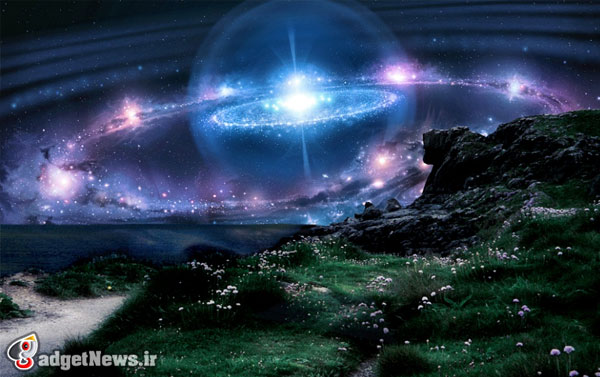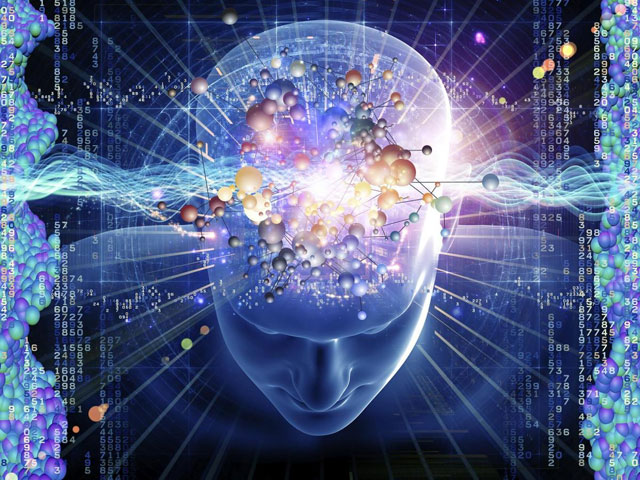
آیا جهان ما واقعی است یا هولوگرامی در پهنه گیتی؟ آیا روزی می توان پرده از راز هستی برداشت و پاسخ مناسبی برای پرسشهای بشر یافت؟ از این دست پرسشها در تمام اعصار ذهن بشر را درگیر خود کرده است، یکی از آن رویدادها در سال ۱۹۸۲ در دانشگاه پاریس به وقوع پیوست. یک تیم تحقیقاتی که توسط فیزیکدان آلن اسپکت هدایت می شد آزمایشی را انجام داد که ممکن است مهمترین آزمایش قرن بیستم باشد. برخی نیز معتقدند کشف او ممکن است چهره علم را دگرگون سازد.
اسپکت و تیمش کشف کردند که تحت شرایطی، ذرات زیراتمی نظیر الکترونها صرف نظر از فاصله بین آنها قادرند با یکدیگر بطور همزمان ارتباط داشته باشند. مهم نیست فاصله آنها از هم ده فوت یا یک میلیارد مایل باشد. هر ذره همیشه به گونه ای می داند که دیگری چه می کند. مشکل این شاهکار در این است که اصل مسلم فرض شده اینشتین را نقض می کند که هیچ ارتباطی نمی تواند سریعتر از سرعت نور سفر کند. زیرا سفر سریعتر از سرعت نور برابر است با شکستن مانع زمان ، این دور نمای ترسناک سبب شده تا برخی فیزیکدانان کوشش کنند با روشهای پر زحمت و به تفصیل یافته های اسپکت را توجیه کنند.
فیزیکدان دانشگاه لندن دیوید بوهم معتقد است یافته های اسپکت دلالت بر این دارد که واقعیت عینی وجود ندارد و در عمل جهان یک هولوگرام تفصیلی شبح گونه، عظیم و با شکوه است. برای درک اینکه چرا بوهم چنین ادعای شگفت انگیزی می کند، باید ابتدا کمی در مورد هولوگرام دانست. یک هولوگرام عکسی سه بعدی است که با کمک لیزر ساخته می شود. برای ساخت یک هولوگرام، شیئی که باید مورد عکاسی قرار گیرد ابتدا در نور یک اشعه لیزر غرق می شود، سپس اشعه دومین لیزر با انعکاس نخستین اشعه برخورد می کند و بر می گردد که به یک الگوی تداخلی منجر می شود. وقتی فیلم ظاهر می شود، یک گرداب چرخشی بی معنی از نور و خطوط تیره بنظر می رسد. اما بمحض آنکه فیلم ظاهر شده با پرتوی اشعه لیزر دیگری روشن شود، یک تصویر سه بعدی از شیئی اصلی ظاهر می شود.

اگر هولوگرام یک گل سرخ از وسط به دونیم شود و بعد با پرتوی اشعه لیزر روشن شود، مشخص می شود هر نیمه باز تصویر کامل گل سرخ را نشان می دهند. در واقع ، حتی اگر این نیمه ها مجددا نصف شوند، باز هم هر کدام حاوی نسخه دست نخورده تصویر اصلی ولی کوچکتر می باشند. برخلاف تصاویر عادی، هر بخش از یک هولوگرام شامل تمامی اطلاعاتی است که کل آن دارد. این ماهیت «کل به جزء» به ما درک کاملا جدیدی از سازمان و نظم می دهد. علم در بخش بزرگی از تاریخچه خود متعصبانه تلاش کرده تا به بهترین روش یک پدیده فیزیکی را درک کرده ، چه قورباغه چه یک اتم، آن را شکافته و بخشهای مرتبط را مورد مطالعه قرارداده است. بوهم معتقد است دلیل اینکه ذرات زیراتمی علیرغم فاصله ای که آنها را از یکدیگر جدا می کند قادرند در تماس با هم باشند این نیست که نوعی پیام مرموز بین هم رد و بدل می کنند بلکه دلیلش این است که جدا بودن آنها، یک توهم است. بحث او این است که چنین ذراتی موجودیتهای مستقل و منفرد نیستند بلکه امتدادی از یک منشاء بنیادی می باشند.
برای اینکه آنچه او می گوید را افراد بهتر بتوانند تصور کنند، بوهم تصویر زیر را ارائه می دهد. تصور کنید یک ماهی درون یک آکواریوم باشد. همچنین تصور کنید که قادر نیستید بطور مستقیم آکواریوم را ببینید، بلکه به وسیله دو دوربین تلویزیونی که یکی در جلوی آکواریوم و دیگری در پهلوی آن قرار دارد قادر به مشاهده آن هستید. همانطور که شما به این دو مانیتور تلویزیونی خیره شده اید، فرض می کنید که ماهی های در هر یک از دو تصویر، موجودیت های متمایزی دارند. دست آخر، چون دوربینها در زوایای متفاوتی نصب شده اند، هر تصویر با دیگری کمی متفاوت است. اما همانطور که به مشاهده دو ماهی ادامه می دهید، سرانجام درک می کنید که ارتباط معینی بین آنها وجود دارد. وقتی یکی دور می زند، دیگری نیز کمی متفاوت ولی مطابق با اولی حرکت می کند، وقتی یکی رو به جلو می رود، دیگری بسوی پهلو می رود. اگر از میدان دید کامل این وضعیت بی اطلاع باشید، ممکن است حتی نتیجه بگیرید که این ماهیها باید بطور همزمان با هم ارتباط داشته باشند، اما واضح است که این صحیح نیست.

بوهم می گوید این دقیقا چیزی است که بین ذرات زیر اتمی در آزمایش اسپکت روی می دهد. طبق نظر بوهم، ارتباط سریعتر از سرعت نور بین ذرات زیر اتمی در واقع به ما می گوید که سطح پایین تری از واقعیت وجود دارد که ما اطلاعی از آن نداریم، یک بعد پیچیده تر، ماورای ابعاد ما که مشابه مثال آکواریوم است. او می گوید ما اشیایی نظیر ذرات زیر اتمی را مجزا از یکدیگر می بینیم زیرا فقط بخشی از واقعیت وجودشان را درک می کنیم. چنین ذراتی بخشهای مجزا نیستند بلکه سطوح کوچکتری از موجودیتی عمیق تر و بنیادی تر هستند که نهایتا بصورت یک هولوگرافیک و نامرئی به نمایش در می آیند، همانند گل سرخی است که پیش از این مطرح شد و چون در فیزیک واقعیت از این تصویرهای خیالی تشکیل شده، جهان خود نیز یک تصویر ناشی از پرتوافکنی هولوگرام است.

در یک جهان هولوگرافیک، حتی زمان و فضا نمی توانند دیگر بصورت واقعیت بنیادی در نظر گرفته شوند. چون در جهانی که هیچ چیز واقعا جدا از چیزهای دیگر نیست فرضیاتی نظیر مکان در هم می شکند، زمان و فضای سه بعدی نیز، نظیر تصاویر ماهی ها در مانیتورهای تلویزیون، باید بصورت تصویر ناشی از پرتوافکنی از یک نظم عمیق تر در نظر گرفته شوند. در سطح پایین تر واقعیت فقط نوعی سوپر هولوگرام است که در آن گذشته، حال و آینده همگی همزمان وجود دارند.
برای مطالعه بیشتر ، کتاب جهان هولوگرافیک نوشته مایکل تالبوت ترجمه داریوش مهرجویی نشر هرمس پیشنهاد می شود.
منابع : crystalinks | dailygalaxy
Is Our Universe a Hologram? In 1982 a Litttle Known but Epic Event Occured at the University of Paris (Today's Most Popular)
What if our existence is a holographic projection of another, flat version of you living on a two-dimensional "surface" at the edge of this universe? In other words, are we real, or are we quantum interactions on the edges of the universe – and is that just as real anyway?Whether we actually live in a hologram is being hotly debated, but it is now becoming clear that looking at phenomena through a holographic lens could be key to solving some of the most perplexing problems in physics, including the physics that reigned before the big bang,what gives particles mass, a theory of quantum gravity. In 1982 a litttle known but epic event occured at the University of Paris, where a research team led by physicist Alain Aspect performed what may turn out to be one of the most important experiments of the 20th century. You did not hear about it on the Daily Show. In fact, unless you are a physicist you probably have never even heard Aspect's name, though increasing numbers of experts believe his discovery may change the face of science.Aspect and his team discovered that under certain circumstances subatomic particles such as electrons are able to instantaneously communicate with each other regardless of the distance separating them. It doesn't matter whether they are 10 feet or 10 billion miles apart.Somehow each particle always seems to know what the other is doing. The problem with this feat is that it violates Einstein's long-held tenet that no communication can travel faster than the speed of light. Since traveling faster than the speed of light is tantamount to breaking the time barrier, this daunting prospect has caused some physicists to try to come up with increasingly elaborate ways to explain away Aspect's findings.University of London physicist David Bohm, for example, believes Aspect's findings imply that objective reality does not exist, that despite its apparent solidity the universe is at heart a phantasm, a gigantic and splendidly detailed hologram. Bohm was involved in the early development of the holonomic model of the functioning of the brain, a model for human cognition that is drastically different from conventionally accepted ideas. Bohm developed the theory that the brain operates in a manner similar to a hologram, in accordance with quantum mathematical principles and the characteristics of wave patterns.To understand why Bohm makes this startling assertion, one must first understand that a hologram is a three- dimensional photograph made with the aid of a laser. To make a hologram, the object to be photographed is first bathed in the light of a laser beam. Then a second laser beam is bounced off the reflected light of the first and the resulting interference pattern (the area where the two laser beams conflate) is captured on film. When the film is developed, it looks like a meaningless swirl of light and dark lines. But as soon as the developed film is illuminated by another laser beam, a three-dimensional image of the original object appears.In a recent collaboration between Fermilab scientists and hundreds of meters of laser may have found the very pixels of reality, grains of spacetime one tenth of a femtometer across.The GEO600 system is armed with six hundred meters of laser tube, which sounds like enough to equip an entire Star War, but these lasers are for detection, not destruction. GEO600's length means it can measure changes of one part in six hundred million, accurate enough to detect even the tiniest ripples in space time – assuming it isn't thrown off by somebody sneezing within a hundred meters or the wrong types of cloud overhead (seriously). The problem with such an incredibly sensitive device is just that – it's incredibly sensitive.The interferometer staff constantly battle against unwanted aberration, and were struggling against a particularly persistent signal when Fermilab Professor Craig Hogan suggested the problem wasn't with their equipment but with reality itself. The quantum limit of reality, the Planck length, occurs at a far smaller length scale than their signal – but according to Hogan, this literal ultimate limit of tininess might be scaled up because we're all holograms. Obviously.The idea is that all of our spatial dimensions can be represented by a 'surface' with one less dimension, just like a 3D hologram can be built out of information in 2D foils. The foils in our case are the edges of the observable universe, where quantum fluctuations at the Planck scale are 'scaled up' into the ripples observed by the GEO600 team. We'd like to remind you that although we're talking about "The GEO600 Laser Team probing the edge of reality", this is not a movie.What does this mean for you? In everyday action, nothing much – we're afraid that a fundamentally holographic nature doesn't allow you to travel around playing guitar and fighting crime (no matter what 80s cartoons may have taught you.) Whether reality is as you see it, or you're the representation of interactions on a surface at the edge of the universe, getting run over by a truck (or a representation thereof) will still kill you.In intellectual terms, though, this should raise so many fascinating questions you'll never need TV again. While in the extreme earliest stages, with far more work to go before anyone can draw any conclusions, this is some of the most mind-bending metaphysical science you'll ever see.
 گجت نیوز آخرین اخبار تکنولوژی، علم و خودرو
گجت نیوز آخرین اخبار تکنولوژی، علم و خودرو 





